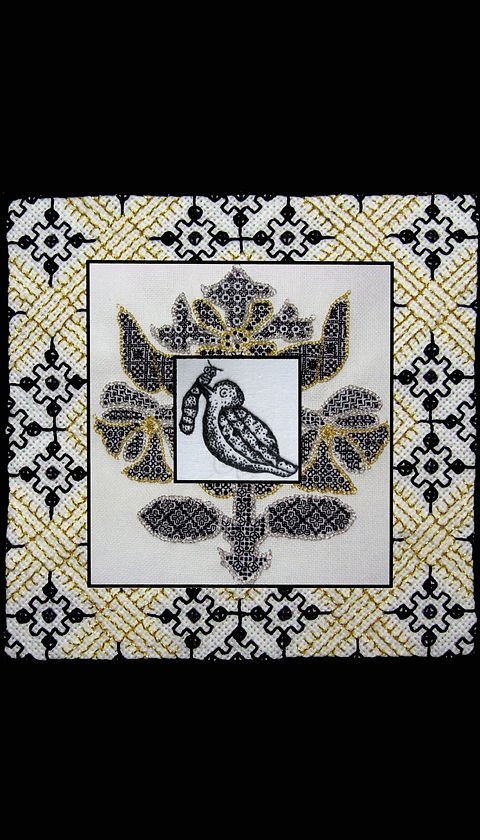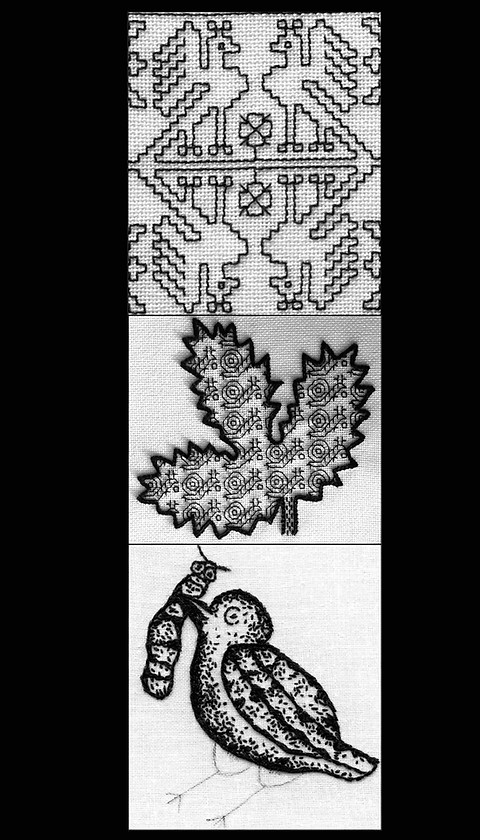I live in Glasgow, Scotland but travel worldwide to teach. If you are interested in having me teach to your organisation or group please contact me for details of fees and travel expenses.
Contact Me
Lectures
All lectures are Powerpoint presentations (1-1 ¼ hours) which require the room to be blacked out. I will bring a laptop and the venue/group are asked to provide a digital projector, screen or suitable wall and an extension lead with two sockets.
Lectures can be followed by a 1, 2, 3 or 4 day school on the same subject.
Please contact me for details of fees and expenses.
Textile Treasures of the Tudors
An illustrated tour of typical Tudor houses showing how textiles made these houses into homes. Includes general information on C16th interiors and furniture, a brief description of the costume of the period, including some wonderful examples of embroidered treasures.
"wroughte with blakke silke"
An in-depth exploration of the development of historical blackwork from C14th Egyptian samplers via early C16th linear Spanish work, geometric patterning of the Elizabethan period to the speckling of the C17th as found in portraits and extant examples.
More than just a pretty face...
Portraits of the C16th and early C17th give vital clues as to the costume of the period. Accurately painted the information contained in them offers an important context in which to set extant embroideries of the time.
Stitch by Stitch
Starting with the earliest European samplers from C14th Coptic Egypt this illustrated lecture will then look primarily at the stitches and techniques found on British samplers up to the eighteenth century.
Shakespeare's flowers in Tudor embroidery
Throughout the C16th and C17th flowers provided embroiderers with a wealth of design material seen on both furnishings and costume in formal arrangements and scattered apparently at random. This illustrated lecture will look at the sources for these designs and the materials and at the techniques which were used to carry them out.
Many a slip...
Embroidered slips were very popular items in historical embroidery from the Middle Ages onwards. This illustrated lecture traces their history, design sources, stitches and techniques concentrating on C16th and C17th examples.
Above the surface: raised embroidery
In the seventeenth century raised embroidery (stumpwork) was very popular for a short time from 1630-1680. This illustrated lecture looks at its origins and its designs and techniques during the C17th.
Articles
Articles in STITCH Magazine
Double knot stitch Issue 37 October/November 2005
From Sketch to Stitch Issue 38 December 2005/January 2006
Raised stem band Issue 40 April/May 2006
A Passion for the past – and the future, article about Chris Berry by Hazel Reid Issue 43, Oct/Nov 2006
Fields of flowers: the embroidered Suzani Issue 56 December 2008/January 2009
Interpretations in Silk: The Work of Hannah Frew Paterson MBE Issue 63 February/March 2010
Red is the Colour (EG5113) Issue 70 April/May 2011
Favourite Things Issue 70 April/May 2011
Simply Red (EG731) Issue 71 June/July 2011
Treasure trove (Mrs St Osyth Wood) Issue 72 August/September 2011
A C17th needlework education - Whitework on sampler EG26-1987 Issue 73 October/November 2011
Treasure trove (Mrs St Osyth Wood's embroidered box) Issue 72 August/September 2011
A C17th needlework education - sampler EG26-1987 Issue 73 October/November 2011
C17th coloured silkwork (EG26-1987) Issue 74 December/January 2012
Mrs St Osyth's Wood's Sampler Book (Part 1) Issue 75 February/March 2012
Mrs St Osyth's Wood's Sampler Book (Part 2) Issue 76 April/May 2012
With kid gloves... (EG1) Issue 77 June/July 2012
Early 20th Century Whitework Embroidery Issue 78 August/September 2012
Twice as Nice: C20th blackwork (EG464) Issue 82 April/May 2013
Crinoline Ladies in Blackwork (project) Issue 82 April/May 2013
For Pleasure and Ornament: Whitney Antiques exhibition review Issue 82 April/May 2013
Italian Cross Stitch: an Embroiderers' Guild folio Issue 87 February/March 2014
Gilt and Silk:C17th costume in the Burrell Collection Issue 92 December 2014/January 2015
Teaching Across the Pond Issue 93 April/May 2015
Stitching the Fantastical: motifs from a woman's coif in the Burrell Collection Issue 99 Feb/March 2016
Art Textiles of the World-Japan book review Vol49 #2 March 1998
Patterns of Childhood; Samplers 1640-1900 exhbition review Vol 56 July/August 2005
Awaken: New Textiles inspired by the Archives and Collection at the Glasgow School of Art exhibition review
Vol 60 May/June 2009
Twixt Art and Nature: English Embroidery in the Metropolitan Museum of Art 1580-1700
Vol 60 July/August 2009
A Mystery Solved - or is it? Research into C17th blackwork fragments Vol 60 September/October 2009
The First Cut: Introduction to Laser Cutting Vol 63 January/February 2012
Miscellaneous
Articles in EMBROIDERY Magazine
Courses based on the Embroidery of the Tudors and Stuarts
(C16th & C17th English embroidery)

4 day course
"wroughte with blakke silke"
An in-depth study of the techniques which fall under the category of blackwork during the C16th and early C17th. Each day will start with an illustrated lecture on a particular aspect of blackwork followed by students working samples of that specific aspect. The aspects covered will be linear blackwork, geometric blackwork, speckling blackwork and other blackwork techniques less easily categorised. Metal thread stitches used with blackwork will also be examined and sampled.
This is a notebook course with samples.

4 day course
Curious
Needleworks
This course is for everybody who loves to stitch, who loves to play with stitches and is curious about stitches in the past, how they developed, how they were passed on from embroiderer to embroiderer. In the late C16th and early C17th amateur embroiderers used relatively simple stitches in ingenious ways to create “curious needle-works” a huge vocabulary of effects based on one or two basic stitches. This stitched-based course will take a structured approach to exploring these stitches. Students will create a notebook based on the great variety of stitches and effects derived from detached buttonhole stitch, the main coloured silkwork stitch of the Elizabethans and early Stuarts.

4 day course
This research notebook course will consider in detail two embroidered accessories of the Tudor and early Stuart period, men's caps and women's coifs. Extant examples are to be found in many museum collections worldwide and the embroidery seen on these includes a wide range of techniques used throughout the C16th & early C17th namely blackwork, coloured silkwork, and metal thread work, embroidery methods used either singly or in conjunction with each other.
Each day will begin with an illustrated detailed lecture on one of the following; blackwork, coloured silkwork, metal thread work followed by students working samples of the techniques based on four specific caps and coifs. Students will also make calico toiles of a cap and a coif.
This is a notebook course with samples.

2 day course
"wroughte with blakke silke"
This is a shorter and less detailed version of the 4 day course above. An illustrated historical introduction of the techniques which fall under the category of blackwork during the C16th and early C17th will be followed by practical experiments in the various methods of the blackwork techniques including linear, geometrical patterning and speckling.
This is a notebook course with samples.

2 day course
Tudor blackwork Caps & Coifs
This course will begin with a detailed lecture of C16th and C17th men’s caps and women’s coifs worked in blackwork. Blackwork is the use of black stitchery on a contrasting material and encompasses many different embroidery techniques; simple linear double running stitch through geometric patterning to speckling. Students will have the opportunity to stitch samples of the various styles. Metal thread stitches enhancing the blackwork will also be discussed. This is a notebook course with samples.

2 day course
Tudor coloured silkwork Caps & Coifs
This course will begin with a detailed lecture of C16th and C17th men’s caps and women’s coifs worked in coloured silkwork. Coloured silkwork uses a variety of stitches based on detached buttonhole stitch and students will sample all these stitches. The metal thread stitchery found on many of these caps and coifs will also be considered and these stitches will also be works as samples. Students will then have the opportunity to work motifs based on Tudor designs.
This is a notebook course with samples.

4 day course
Stitch by Stitch
This course will offer students the opportunity to try a wide variety of stitches found in sixteenth and seventeenth century samplers.
The aim is to start an illustrated notebook of stitches using images from historical samplers and embroideries – a sort of sampler in print! It will cover coloured silkwork techniques using flat to raised detached buttonhole stitches, the various techniques associated with the term blackwork and some whitework techniques. This is a notebook course with samples

2 day course
Unravelling Tudor Stitches
From portraits and extant textiles from the sixteenth and early seventeenth centuries we see superb embroideries with designs of scrolling stems enclosing flowers worked in coloured silk work and metal thread. Many of the stitches are based on one stitch - detached buttonhole stitch which can give a variety of different effects. The aim of this course is to find out how to work these stitches and to be able to recognise them. Students will work samples and then use this knowledge to stitch this scrolling stem design.
About Me
I have two passions, C16th & C17th English embroidery and Venice.
I teach courses and give lectures based on my extensive research of embroidery stitches and techniques of the Tudor and Stuart periods.
Venice, its architecture and reflections, is the inspiration for my personal work which has been exhibited with the Textile Study Group (formerly the Practical Study Group) and with the Embroiderers' Guild, locally, nationally and internationally.
As elected Chairman of the Embroiderers’ Guild (2002-2008, I was the Chair of the Selectors for the biennial International Exhibition art of the Stitch from 1999 to 2009.
I am a contributing author to the Textile Study Group publication Embroidery Studio (David & Charles) in which we took inspiration from historic and foreign textiles from the Embroiderers’ Guild Collection and produced a contemporary work of art based on our study. I was a regular contributor to Stitch Magazine 2005-20016, and occasional contributor to Embroidery. My work has recently featured in Artistry in Fibre: Wall Art Published by Schiffer Publishing USA.
CHRIS BERRY
Independent Textile researcher and tutor
Embroidery courses and lectures based on C16th and C17th embroidered textiles
